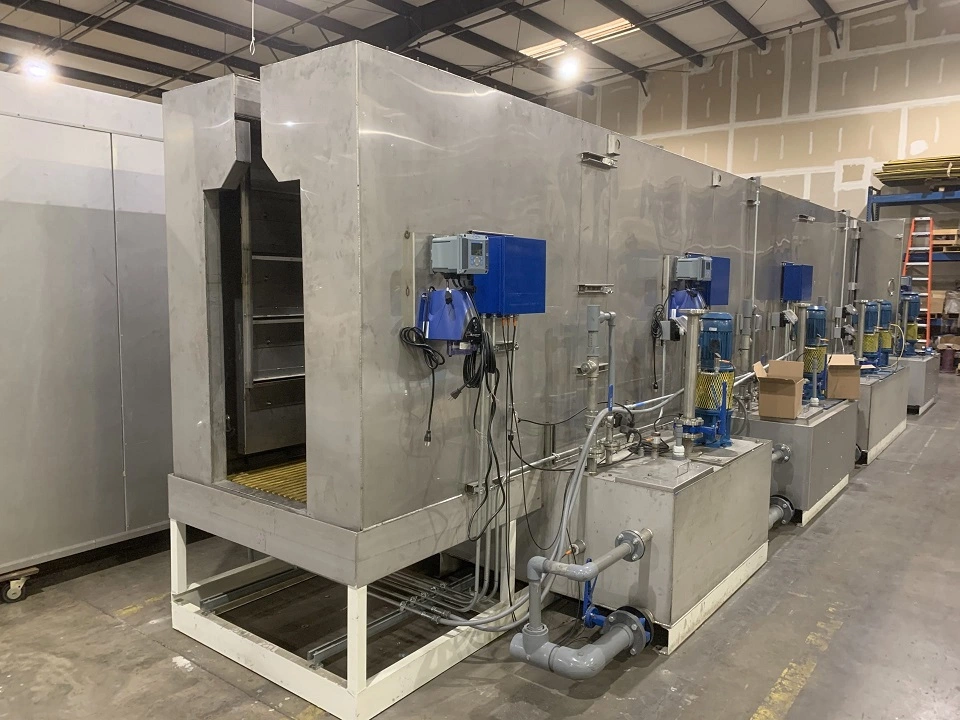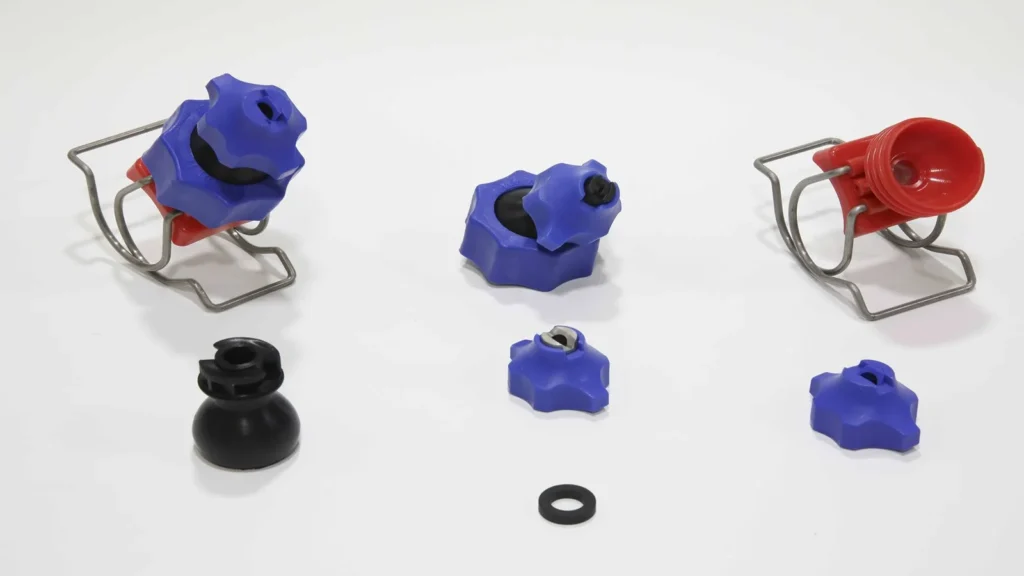
In this section, you can find some brief information about the pretreatment for powder coating, used in factories for cleaning surfaces before applying powder
Powder coating is an advanced method of applying a decorative and
protective finish to a wide range of materials and products that are used
by both industries and consumers.
The powder used for the process is a mixture of finely ground particles of pigment and resin, which is sprayed onto a surface to be coated. The charged powder particles adhere to the electrically grounded surfaces until heated and fused into a smooth coating in a curing oven. The result is a uniform, durable, high-quality, and attractive finish.
What is the pretreatment for powder coating?
Pretreatment means surface preparation. Here by pretreatment, we mean metal pretreatment as the powder coating is predominantly applied to metals. Surface preparation includes:
Cleaning – mechanical or chemical
Mechanical cleaning includes methods like scratch brushing and sandblasting. This abrasive action not only removes surface impurities but also eliminates scratches and surface irregularities. Cleaning is very good, however, the coating must be done immediately because the cleaned surface is in a highly reactive state and corrosion occurs very soon.
Chemical cleaning includes the removal of dirt, oil, and grease, and the oxidation products present on the surface by means of chemicals. The chemicals may be applied by wiping, spraying, or dipping. The nature of chemicals used depends upon the base metal and will be discussed later in detail. Application of conversion coating.
Conversion coating. – These are applied for three purposes:
1) Provide temporary in-process corrosion protection before the application of powder coating.
2) Promote good adhesion of the powder coating to the substrate.
3) Impart under paint corrosion & thereby improve the life of
the powder coating. The type of conversion coating used also depends upon the base metal and will be discussed later.

Application of conversion coating
Conversion coating. – These are applied for three purposes: 1) provide temporary in-process corrosion protection before application of powder coating. 2) promote good adhesion of the powder coating to the substrate. 3) impart under paint corrosion & thereby improve the life of the powder coating. The type of conversion coating used also depends upon the base metal and will be discussed later.
The Tendency of Material:- picking up rust when exposed to
atmosphere bare.
NEED OF CLEANING – Presence of oil, grease, rust, and black scale on
the surface. Mild Steel material is known for it’s tendency of going under rapid oxidation when exposed to the atmosphere bare. The result of oxidation is the formation of an oxide layer on the surface which we commonly call as ‘RUST’.
To avoid this oxidation or rusting, the mild steel material is not allowed to get directly exposed to the atmosphere. For this, we generally find rust preventive oil on the surface of mild steel material. The oil does not allow the material to come in direct contact with air and thus delays oxidation. However, this doesn’t entirely eliminate the problem of rusting and it only delays the process of rust formation.
Some mild steel materials are hardened for strengthening and similarly some are welded during fabrication. Both these processes leave a black scale on the surface. In short, mild steel parts generally have rust and/or grease-oil and/or black scale on the surface. All these cause severe problems of bonding if not removed before the application of paint.
Before painting, once the rust, oil, and scale are cleaned, the bare metal is again exposed for oxidation. To avoid this, the material has to be coated with some type of conversion coating which prevents further oxidation before applying paint and also gives adhesion for the paint.
Precleaning of Mild Steel

DEGREASING – Removal of oil and grease from the surface.
This can be done by Solvent-Based Degreasing:- Petroleum-based solvents have excellent degreasing abilities but are not commonly used because they are highly inflammable.
Alkaline degreasing powders:-
This is generally a blend of alkalies and surfactants. This is advised to be used under hot conditions. However, alkaline powders are also used under cold conditions during the knock-out degreasing stage.
Acidic Degreasing:-
These are solvent-based liquids that are acidic in nature. They remove rust as well as grease under cold conditions. The bath of these chemicals is, however, much more expensive as their concentration is much higher than alkaline degreasing.
These are necessarily acidic chemicals unlike degreasing, which may be
alkaline in nature. The chemical is generally a blend of mineral acids like
phosphoric acid, sulfuric acid and hydrochloric acid with added inhibitors.
Higher acidity will result in faster removal of rust. However, this will affect the life of the coating applied later. Phosphoric acid-based derusting chemicals are most suggested for the pretreatment of mild steel before applying paint.
Conversion Coating of Mild Steel about the Pretreatment for Powder Coating
The most common types of conversion coating include :
• Zinc phosphate coating
• Iron phosphate coating
Zinc phosphate coating is crystalline heavy coating gray in color. While iron phosphate coating is an amorphous conversion coating that ranges in color from iridescent blue to gray.
Iron phosphate coating gives minimum sludge formation and hence a smoother finish than zinc phosphate. Apart from this, the bonding characteristics are also good. Iron phosphate processes are much easier to operate than zinc phosphate processes and require fewer process stages (zinc phosphate coating requires a dip in activation chemical prior to phosphating to have a microcrystalline grain structure), but iron phosphates do not provide the degree of corrosion protection imparted by zinc phosphates.
Iron phosphate systems are therefore used for a range of products requiring a durable finish that is not exposed to severely corrosive environments. Zinc phosphating processes have been developed to provide exceptional painted part durability in corrosive requirements. Typical industries using zinc phosphate processes include automotive, appliance and truck, and bus.
Post Treatment in Powder Coating
After a metal surface receives a conversion coating, the surface is water rinsed to remove unreacted conversion coating chemicals and a post-treatment is applied. The post-treatment can provide a two- to ten-fold increase in corrosion resistance and humidity resistance when compared to conversion coatings without final rinses. Post-treatments are generally based on chromic acid.
Sequential Process of Pretreatment for Powder Coating
Seven (or eight) stage treatments for zinc/iron phosphate include the following stages:
- Degreasing
- Water rinse
- Derusting
- Water rinse
- Activation: This gives a more compact and uniform coating of zinc
phosphate. This step can be omitted for the iron phosphate process. - Phosphating: This forms a coating of zinc phosphate (4 to 6 microns)
OR iron phosphate (1 to 1.5 microns) on the clean surface of M.S. - Water rinse
- Passivation: This will seal the pores of phosphating.
- Drying.
Clean Coater in pretreatment for powder coating
Cleaner-coater system for mild steel is a much-simplified treatment than 8 tank process. This is done in a single tank with 3 in 1 che1mical. In this system, all three processes of degreasing, derusting and iron phosphating are done with a single chemical, thus making the processing time effective. However, its corrosion resistance and bonding properties are not as good as that of 8 tank process.)
Aluminum has a tendency to undergo natural oxidation forming a thin layer of aluminum oxide on the surface. Apart from this, the commonly known process of anodizing also leaves a layer of aluminum oxide under the influence of an electric current. This is not a good base to apply powder or any other coating. Hence, it must be removed before powder coating. Apart from this, there may be oil on the surface that may have come during the fabrication process. This must be removed to have proper bonding of powder coating.
Alkaline Cleaning & Acidic Cleaning
Strong alkaline cleaners
Mild alkaline cleaners
The aluminum material is very sensitive to alkaline attack. These alkaline cleaners are milder for aluminum than for mild steel. However, if there is an anodizing layer on aluminum, the caustic soda-based strong alkaline cleaner has to be used. However, this leaves black smut on the surface. To remove this aluminum is deeped in a weak bath of nitric acid.
Acidic Cleaning
These are based on phosphoric acid. They are capable of removing anodizing layer without the formation of black smut and hence reduce the additional step of rinsing in nitric acid.
Conversion Coating for Aluminum
• Chromium Phosphate coating – Green in color
• Chromate coating – Yellow in color
Six-stage treatment for aluminum include following stages:
- Alkaline Degreasing
- Water Rinse
- Nitric acid
- Water Rinse
- Chromating
- Water Rinse
Alternatively, four stage treatment for aluminum is as follows. - Acidic Degreasing
- Water rinse
- Chromating
- Water Rinse
Cleaner-coater system for aluminum is a much-simplified treatment than 6
tank process. This is done in a single tank with 3 in 1 che1mical. In this system, all three processes of degreasing, oxide layer removal, and aluminum phosphating are done with a single chemical, thus making the processing time effective. However, its corrosion resistance and bonding properties are much inferior to the conventional chromatizing process.
Problems because of improper pretreatment for powder coating
Pretreatment is the base for powder coating. It is said that you can not make a good coating work with poor pretreatment. Hence utmost care should be taken to ensure proper pretreatment is applied before powder coating. Proper pretreatment means application of the right process and proper maintenance of the chemicals.
PROBLEMS BECAUSE OF IMPROPER CLEANING
- The appearance of oily patches.
- The appearance of pin holes.
- The appearance of the rusty surface beneath powder coating film.
PROBLEMS BECAUSE OF IMPROPER CONVERSION COATING:- - Reduced resistance to weather.
- Reduced mechanical resistance.
- Poor finish of the powder coating film.
PROBLEMS BECAUSE OF IMPROPER DRYING:- - The appearance of pin holes.
- Poor bonding of the powder coating film.
These problems can be avoided by the choice of the right process – the right chemicals and proper
maintenance of the chemicals.
EMS Powder Coating Equipment
Powder coating equipment is used to apply a thin layer of powder over a metal surface. This type of coating is applied by an electrostatic process and is a very popular method for finishing metal parts.
This type of equipment can be divided into two main categories: automatic and manual. Automatic booths are more popular because they provide better production rates, but they are also more expensive.
A powder booth is an enclosure in which the powder-coating process takes place. Powder-coating equipment includes an oven where the parts are heated to activate the powder, a gun that sprays or brushes on the powder, a conveyor belt that moves parts through the oven, and cartridge-type guns for applying thicker coatings with less overspray.
Powder coating is a technique that is used to provide a finish to metal parts. This technique has been in use for many years and it is still one of the most popular techniques today.
Powder coating equipment consists of booths, ovens, guns, machines, lines and conveyors. A booth can be either automatic or manual. An automatic booth is more expensive than a manual booth but it is also faster and more efficient.
